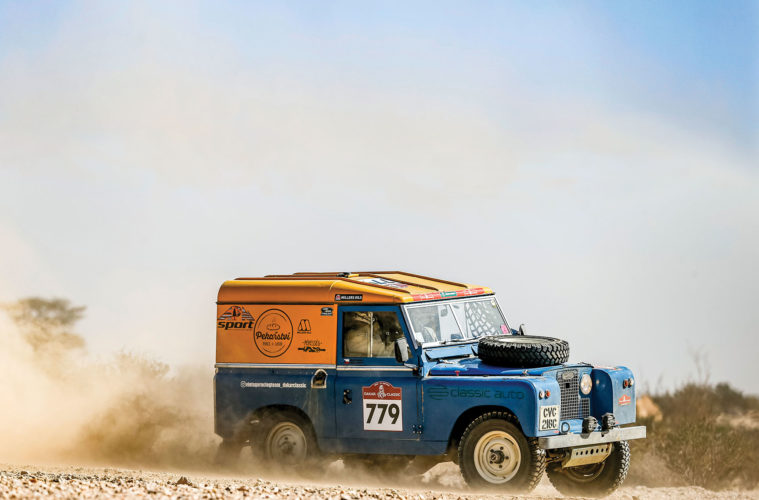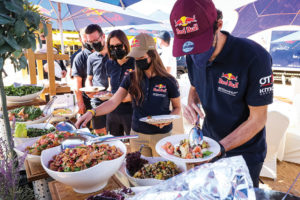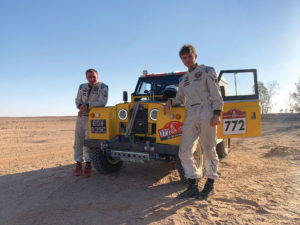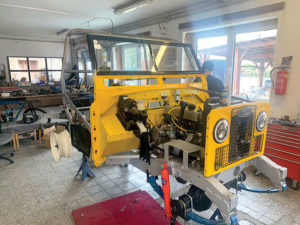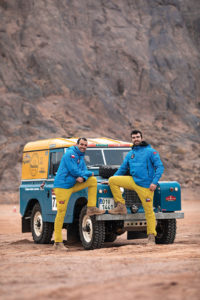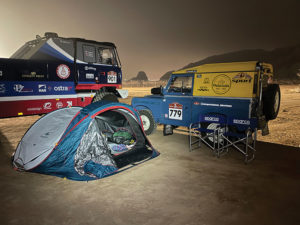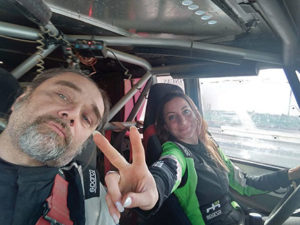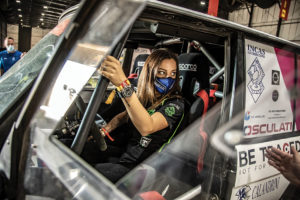Land Rover has always instructed off-roaders to travel, “as slow as possible, as fast as necessary.” The Dakar Classic, held this past January in Saudi Arabia, turned that mantra on its head.
Over 13 days of racing, hundreds of teams tackled 5,215 miles of driving – 2,563 miles of it on special, off-road stages. In between lay 2,652 miles of desert roads or tracks, all to be completed within strict time limits.
What was it like to compete in a famous international race across Arabian desert routes – in heritage Land Rovers? Three teams entered Series Land Rovers, seven ran Range Rover Classics and one competed in a Defender [see Winter 2022 issue -ed].
We reached out to many of these teams to get behind-the-scenes insights – from the driver’s seat to under the hood and even beneath the Land Rover:
Team # 772 – ’64 Series IIA, Dusan and Frankie Randysek
Dusan Randysek, 51, a self-employed mechanical engineer and experienced off-road motorcycle racer, lives in Hranice, Czech Republic. For over a decade, he had stared at the Series IIA in his backyard. “My son, Frankie, and myself, we love this Land Rover very much; it’s the only 4×4 we’ve ever owned. It still had its original 3-bearing 2.25L engine.”
“The decision to run the Dakar in the Land Rover was spontaneous,” Dusan said. “I had offers to race on a motorcycle this year, but I wanted to do something with my son, Frantisek. So I decided to close up my shop and ‘Frankie’ and I would rebuild the Land Rover.”
“Frankie had grown up around me, building cars and traveling with me to desert races, such as in Tunisia. Many of my racing colleagues knew of him. But with this Dakar, he witnessed the competition from a completely different view.”
“The biggest challenge in the Dakar is that you’re always on the move. You must be ready to race each day, and if a mechanical problems stops you for a few hours, you are out of the running for a prize. Of course, we had to install required safety items, like a roll cage, but I knew we would be running the race without a team of mechanics and support trucks, so we focused on reliability. For example, I bolted up a spare fuel pump and coil; in case of failure on the course, we could quickly change out the hose and wiring. I knew that the leaf spring suspension and small engine would be challenges for us, but we used strategy to play their game. In fact, on one stage, we were actually too fast [and received penalty points].”
Each day required signifiant mileage at speed. Dusan recalled, “On the first day, we had to drive 200 miles just to reach the start, then 150 miles of the special stage, then another 200 miles to the finish for that day. Four hours of that day was run at 70 km/h.”
“Our only mechanical problems arose on Day 3, and they involved the wheel hubs. I didn’t realize that we had a bent axle shaft, and that put quite a strain on the wheel flange bolts. Fortunately another team had a spare axle shaft and wheel flange.”
“We were able to finish the race, 119 our of 160. The finish was our goal. The French organizers told us that we would never be competitive. It felt good to prove them wrong!”
Frankie Randysek, 18, studies acting in Prague; he called the Dakar experience “an absolutely unforgettable journey. Competing in the event with my father was always fun. We worked well together and managed not to get into major arguments; we turned out to be good teammates. My father had participated in other off-road races during my childhood, so I shared some experiences with this kind of rally. I’m glad I have this strong relationship with my father, and I hope everyone can find the same kind of opportunity.”
Dusan agreed that “the most important part of the rally for me was that I did it with my son. He was the youngest driver in the race, and he gained maturity from it. My message to readers thinking about running the Dakar is, make it happen. Time is short and you must do this while you can!”
Team #779 – ’65 Series IIA, Stepan Pance and Albert Pance
Stepan, age 27, earned his mechanical engineering degree from Czech Technical University with a specialization in automotive engineering. He works at Skoda, the Czech Republic’s largest automotive manufacturer, but his passion for “vintage cars” came from his father, now age 65.
“Our dad always dreamed of having classic cars,” Stepan said, but he had to wait until the ‘Velvet Revolution’ of late 1989 ended Communist rule. That enabled him to indulge in his passion.” In the early 2000s, he purchased a Jaguar XKE convertible “that we still have, and we still love it.”
Stepan’s older brother, Albert, age 38, had run the Dakar Classic in 2021 and eagerly looked forward to running a vehicle again in this year’s event. Stepan and Albert engaged the help of the Land Rover Series Club, Czech Republic, to source a vehicle. Stepan noted, “They’re an informal group, but they always seem to have some RHD Series Land Rovers from the UK on hand. We bought ours from them and named him ‘Cecil.’ It had been sitting for decades and required a lot of work to get it into rally condition. It was our first ever 4×4.”
Since “Cecil” had sat for over 30 years, it required engine, drivetrain and brake system renovations to prepare it for the Dakar. To meet rally safety requirements, Stepan said, “We had to put in a roll cage, 6-point racing safety harnesses and racing seats. To meet the driving distance requirements, we installed twin fuel tanks and a manual fuel change-over tap, like those on military Land Rovers. We also installed wiring connections for the safety GPS and satellite communications.”
Once underway, Stepan and Albert ran into two major issues – one expected and one totally unexpected. The first was fuel vaporization, caused by the high engine temperatures when running at high rpm and race speeds. The rapid installation of a low-psi, electric fuel pump solved that problem.
The second issue proved thornier. Although the engine rebuild prior to the race used new parts, “Cecil” suffered from valve spring failures. When the Land Rover stopped running smoothly, Stepan and Albert removed the rocker arm cover to discover three broken springs. Stepan recounted, “we found we could remove and swap out the springs without removing the head, but no one had any spare valve springs. During a bivouac, I took an Uber to a city 15 miles away. I found a shop that had 20–30 old heads and a bunch of valve springs. I found two with similar dimensions and returned to the camp. We jury-rigged a system to prevent losing the valve down into the cylinder, moved the piston to TDC and started off the next day.”
“About 300 km later, another one broke! We drove on but had to bypass the special stage. Two days later, another one broke, and it became clear that we had purchased a bad batch of new springs.” A plea to the Czech Land Rover Club resulted in queries to UK enthusiasts that led to a contact in Saudi Arabia, Faisal Al Osaimi. Stepan said, “He’s a Land Rover enthusiast who works in a hospital, but in his free time, he works on his Land Rovers. He had spare parts, but Series Land Rovers in Saudi Arabia are very rare. There are maybe 20 in the country, and he owns 10 of them.”
Faisal recalls, “When I got the message for help, I thought that my cousin was joking me!” On a Sunday, Faisal invited Stepan to his apartment to help source the needed parts. “I woke up the whole building as I didn’t know which apartment was his,” said Stepan. With Faisal’s help, they went to an engine repair shop where they cannibalized 8 valve springs and spent the next four hours installing them into Cecil’s engine.
The remainder of the race went on without incident. Stepan summed it up. “The Series IIA was tough to ride in, but we were running to enjoy it, not to win. It was a journey that made no sense, but we really wanted to participate in the Dakar!”
Team # 734 – ‘92 Range Rover Classic, Rebecca Busi and Roberto Musi
[Despite official biographies and online posts, Roberto Musi is not Rebecca’s father. Her father is Roberto Busi. The families with similar names live in the same village, hence the confusion. Rebecca wanted to correct the record – Team #734 was not a father-daughter team -ed.]
Rebecca Busi, 26, Lagaro, Italy, grew up in a family in which her father raced motorcycles in the desert. “When I was 6, I went to Tunisia and Morocco with my father. Our annual vacations were in deserts; I feel as though I grew up in the middle of the desert. I followed my father in the races and it became my passion. I am his daughter, for certain!”
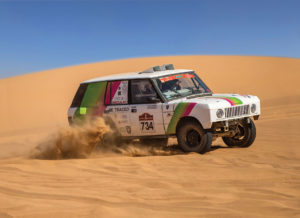
“I never knew how exciting it was, but my father told me, if you could finish the Dakar, you could do any race. It became a bet with myself. If you have enough courage, you can do anything.”
Rebecca’s family owns Calandrini SRL, which produces and distributes liturgical items for Catholic churches worldwide. Having graduated university with a degree in economics, Rebecca is continuing her pursuit of a Global Executive MBA through EAE Business School in Barcelona. Taking a break from her studies one night, she noticed on social media that her father’s friend, Roberto Musi, had lost his driver for the Dakar. She messaged him and said, “I’m available!”
“I had never driven a Range Rover. My first time driving one was the first day of the Dakar,” Rebecca said. “It’s not a difficult car to understand, but there were many points to learn. I always drive cars in the city, so the shift to off-road conditions took 2–3 days to understand. The Range Rover was the best car for me to learn on and make the change. It helped me because of its quiet and comfort, and its capabilities help you while you’re learning. The Range Rover hid my mistakes.”
The team finished in 114th place, and the experience fired Rebecca up to take on more desert races. “I will be leaving soon to drive side-by-side with a driver in another race in Tunisia. I want to grow as a driver, so I need to try a more powerful vehicle.”
Rebecca would also like to see “more female drivers in motorsports. My father told me before the first stage, I was smiling and I looked so proud. To be a motor shop rat, you need to do it with passion. I would like to see more drivers with passion, not just time, money and opportunity. I want race driving to be my job; when your job meets your passion, you will never ‘work’ in your life.”
“To the younger drivers, you must find the courage to start. Find the road to pursue to your dream. If you are just dreaming, you are missing out. Find the courage to do it. I always knew that desert driving was my dream. I dream of the dunes all the time, even now after the race. I know nothing else as exciting to me.”
At age 58, Roberto Musi has curated a dream life for himself; he created Sahara Dreams, an off-road, North Africa-based adventure company, and a Land Rover specialty shop of the same name in Bologna. His extensive experience as a driver, mechanic and event organizer in desert rallies has enabled his company to bring over 200 groups to North Africa since its founding. His Italian trail leaders and capable Tuareg guides seek to expose the marvels of the desert landscape and social culture to novice and experienced travelers.
Roberto bought his first Land Rover 38 years ago. His many years of “raids” in Range Rovers led him to create custom suspension components for off-road rally competition, and he knows how to prepare a vehicle for a rally as challenging as the Dakar. Roberto’s mechanical skills were put to the test during this year’s event.
Roberto noticed that his Range Rover Classic developed a problem after the second stage when it began to run hot. First, he checked out the coolant piping; later, he swapped out the thermostat, but those easy fixes did not reduce the engine temperature. While the Range Rover ran competitively, it appeared to be losing coolant without obvious leaks. That led to replacing the head gaskets, starting with removing the heads at night, and then replacing the head gaskets on the following day, which fortuitously was the rest day for the event. “One head bolt was very stubborn,” Roberto said nonchalantly. “Nothing is easy in the desert.”
Rebecca professed her amazement at the speed of the field repair, as well she should. The flat-rate time at a dealership for a 3.9 engine is 15 hours; shops have done it more quickly indoors when the head has no warpage. To perform the operation at night, under a canopy in the desert, and then complete the reassembly – solo – is quite a remarkable repair. Even more impressively, the Range Rover ran perfectly for the remainder of the rally.
“In a nutshell,” Roberto said, “the Dakar is the highest achievement for desert racing.” Looking ahead, Roberto wants to compete again in 2023. “Yes, it’s almost sure that I will run a Range Rover again in 2023. Maybe a two-car team with a Range Rover and a Defender 130.”
For all the teams, the time and financial commitment was substantial. The cost of entering a two-person team in 2022 was $18,000, which covered shipping the Land Rovers for tech inspection (for European entries, to Marseille, France) and delivering them to Saudi Arabia in time for the rally. In addition, the fee covered airfare for the competitors, as well as their food and tent lodging during the event.
The Dakar Rally moved from South America to Saudi Arabia in 2020, and will return in 2023. Over the past five years, the kingdom has aggressively sought to host major motor racing events, from the Dakar to the Formula 1 Saudi Arabian Grand Prix and – its latest this March – the all-female Rally Jameel, a milestone in the country’s recent efforts to expand rights for women (the kingdom granted women the right to drive in 2017). Mark Vaughn of AutoWeek wrote, “Maybe motorsports isn’t the cure-all for the world’s woes, but it would be a nice start.”
